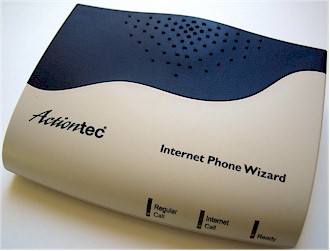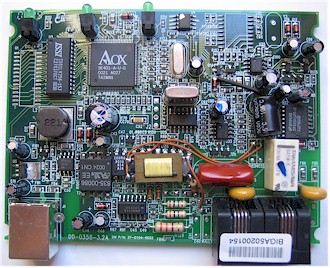The Pitch and Product

| Actiontec Internet Phone Wizard with Skype | |
|---|---|
| Summary | USB adapter for using your phone with Skype. |
| Update | None |
| Pros | • Quick and easy installation • Automatically switches between incoming Skype and PSTN calls |
| Cons | • Requires your PC to be on for Skype calls • No incoming Skype caller indication • Win XP / 2000 only |
Actiontec’s Internet Phone Wizard with Skype (IPWS) is essentially a reworked version of its discontinued (but still available) USB Internet Phone Wizard. Both products are used to connect good old analog telephones to Internet-based telephone services. But where the discontinued USB Internet Phone Wizard worked with an assortment of “traditional” VoIP service providers, the IPWS works only with alternative (and free) VoIP provider Skype.
Skype is the latest step in the evolutionary chain of free Internet-based telephony. Skype was created by KaZaA founders Niklas Zennström and Janus Friis, and combines instant messaging, voice telephony and file transfer capabilities into one application. Skype is pretty adept at getting around firewalls (unless it is intentionally blocked) and unlike “traditional” VoIP services uses a proprietary call-control protocol instead of SIP or MGCP. Its main attraction is that it is free for in-Skype-network calls, although it also has a SkypeOut pay-as-you-go option for outgoing calls to the PSTN (traditional telephone network).
The IPWS comes in a beige and blue plastic enclosure that is about the size of a naked 3.5″ hard drive. Indicator lights are on its front panel and all jacks are on the rear.

Figure 1: Back panel – no Ethernet
A glance at Figure 1 shows that the Wizard has a USB, not Ethernet connector, which means that it must be hosted by a computer (Win XP / 2000 only). The good news is that the box powers itself from the USB port, but the bad is that your computer must be on, and running Skype, for the IPWS to do its thing. This is different from a “traditional” VoIP Analog Telephone Adapter (ATA), which connects to your LAN directly via Ethernet and has all the smarts it needs to make and receive calls embedded inside.
Figure 2 shows the board, which looks like it needs another revision to get the rework incorporated into it. It is based on an AOX / Endpoints SE 401 USB Video Imager Controller, that is more commonly found in webcams.
Figure 2: The board
(click image to enlarge)
Installation is quick and easy using the printed Quick Start Guide, especially since most buyers will already have Skype installed. I just loaded the CD that came with the IPWS into my computer running Windows XP Home SP2 and connected the IPWS itself to one of the computer’s USB ports using the supplied cable. The Windows Found New Hardware Wizard came up and took care of the rest while I used the short phone cable that also came with the IPWS to connect my phones and phone line to the clearly-marked jacks on the back of the IPWS.
I then installed the IPWS application onto my Win XP machine, assigned speed-dial numbers to the Skype contacts that I wanted to be able to easily reach out and touch and I was ready to make and receive calls. Note that the IPWS software requires that you enter an e-mail address during setup, but you can just enter a bogus one.
The Test and Verdict
The IPWS application auto-launches when you boot and runs in the System Tray / Notification area. It has no adjustments for you to fiddle with and uses three different icons to communicate status of Ready, Not Connected or In-Use. But I couldn’t tell the difference between the Ready and Not Connected icons and found it easier to just look at the Ready, Regular Call and Internet Call status lights on the front of the IPWS itself.
Skype and the IPWS application communicate as needed to manage Skype and PSTN calls. If for some reason you quit Skype, the IPWS software will launch it when you go to make a call. But I found the IPWS application doesn’t wait long enough for Skype to get up and running, so you’ll have to hang up and start the call again. I also found that if I quit the IPWS application and then tried to quit Skype, Skype just hung until I killed it from the Windows Task Manager.
Once everything is running, you just hit ## on your telephone keypad, wait for the European-style dial tone and punch in the speed-dial code. Although the IPWS works for both Skype and Skype-Out calls, you can only use speed-dial codes to call Skype network users. You’ll have to dial Skype-Out calls as you would on an ordinary phone, but with a 00 or 001 prefix.
The IPWS automatically switches incoming Skype or PSTN calls to the connected phone(s), and even gives you a double ring to indicate a Skype call. Caller ID works fine for PSTN calls, but you get no indication of who is calling on an incoming Skype call. Other nice touches are that you’ll get a familiar call-waiting beep if a call comes in on the other line when you’re on either a PSTN or Skype call. You use ## to switch between “lines” and if you hang up and forget someone you left holding on the other line, the IPWS will ring you back so that you can complete that call. And when the computer it’s connected to is shut off, the IPWS defaults to connecting its Phone and Line jacks together so that you can make and receive PSTN calls.
I made and received a few test calls and enjoyed not getting tangled in the long cord of the headset that I had been using for Skype calls. And I didn’t really miss the higher-fidelity of a headset-based Skype call (your typical telephone is not intended to be a high-fidelity instrument), although the difference surprised me at first. I did have one odd occurrence where a Skype caller could hear my wife on a simultaneous PSTN call but I couldn’t hear her. I didn’t have time to try to reproduce the problem before deadline, but I suspect the problem might have been caused by us both using cordless phones, although I don’t know for sure.
If you’re a heavy Skype call user and want the convenience of Skyping from the same phone(s) you use for normal calling, the IPWS can be just the ticket. But with a little Googling / Froogling you can find similar products from less-familiar vendors and save $10 – $20 from the $60 or so the IPWS currently goes for. Buffalo Technology and others also have recently announced Skype “partnerships”, so even more choices should be available soon.

